In this context a lattice is a mathematical structure with two binary operators: \/ and /\.
The lattice structure arises in algebras associated with various branches of mathematics including logic, sets and orders. These branches of mathematics tend to use different names and notations for corresponding concepts as follows:
| Lattice | Logic | Set | Order |
|---|---|---|---|
| => | ≤ | ||
| <=> | = | = | |
| top T | true | universe | empty meet /\Ø |
| bottom _|_ | false | Ø | empty join \/Ø |
| /\ meet | conjunction,and |  intersection intersection |
greatest lower bound glb infimum inf |
| \/ join | disjunction,or | U union | least upper bound lub supremum sup |
So we can approach lattices in different ways:
- We can define them using the concept of 'order', that is, as a partially ordered set (poset).
- We can define them using algebraic identities.
 |
This lattice structure can be visualised as a diagram with nodes and lines between them, this diagram is called a Hasse diagram. This has some similarities to a graph structure however the lines in a lattice structure have a notion of 'ordering' and there will be a highest node at the top and a lowest node at the bottom. |
A big application of mathematical lattices is when factoring is involved somehow.
Categorisation of Lattices
| If a lattice represents a completely ordered set (a>b or a<b is valid for any two elements) then the lattice is just a vertical line. | ||
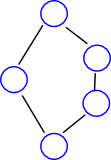 |
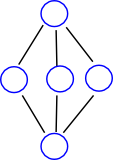 |
 |
|---|---|---|
| N5 | M5 | O6 |
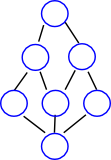 |
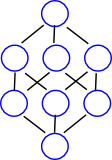 |
 |
| L7 | 23 | P6 |
Lattice and Partially Ordered Sets
A lattice is a partially ordered set in which any two elements have a least upper bound and a greatest lower bound.
For partially ordered sets:
- the join operation represents the least upper bound of an arbitrary set of elements.
- the meet operation represents greatest lower bound of an arbitrary set of elements.
A partially ordered set where both the join and the meet of any two elements always exist is a lattice
- A partially ordered set where the join of any two elements always exists is a join-semilattice.
- A partially ordered set where the meet of any two elements always exists is a meet-semilattice.
- An n-ary relation on a set A is a subset of An
- The inverse r¬ of a binary relation on A is specified by <a,b>
 r iff <b,a>
r iff <b,a> r
r - The relational product r o s of two binary relations r,s on A is given by <a,b>
 r o s iif for some c: <a,c>
r o s iif for some c: <a,c> r <c,b>
r <c,b> s.
s.
Completeness
If a poset/lattice has completeness properties then it can be described as an algebraic structure.
The presence of certain completeness conditions allows us to regard the formation of certain suprema and infima as total operations of an ordered set. It turns out that in many cases it is possible to characterize completeness solely by considering appropriate algebraic structures in the sense of universal algebra, which are equipped with operations like \/ or /\. By imposing additional conditions (in form of suitable identities) on these operations, one can then derive the underlying partial order exclusively from such algebraic structures.
| completeness | requires negation operation | |
|---|---|---|
| lattice | ||
| semilattice | ||
| Heyting algebra | 'pseudo complement' | |
| Boolean algebra | 'not' operation |
Algebra of Lattice
An important algebra is a lattice, it has two operations:
- meet /\
- join \/
identities:
| identity | meet | join |
|---|---|---|
| commutativity | x /\ y = y /\ x | x \/ y = y \/ x |
| associativity | (x /\ y) /\ z = x /\ (y /\ z) | (x \/ y) \/ z = x \/ (y \/ z) |
| idempotency | x /\ x = x | x \/ x = x |
| absorption laws | x \/ (x /\ y) = x | x /\ (x \/ y) = x |
there are also distributive laws which may, or may not, apply for a particular lattice.
| identity | |
|---|---|
| distributive /\ over \/ | x /\ (y \/ z) = (x /\ y) \/ z |
| distributive \/ over /\ | x \/ (y /\ z) = (x \/ y) /\ z |
Example - Factorising integer
As an example of a lattice we will look at factorising an integer, in this case 120. The following table the columns represents an integer we are trying to factorise and the row represents the the integer we are trying to factorise by. The entry in the table is a boolean value where '' represents true and blank represents false depending on whether row is a factor of column:
| Is-a-factor-of | 1 | 2 | 3 | 4 | 5 | 6 | 8 | 10 | 12 | 15 | 20 | 24 | 30 | 40 | 60 | 120 |
|---|---|---|---|---|---|---|---|---|---|---|---|---|---|---|---|---|
| 1 | √ | √ | √ | √ | √ | √ | √ | √ | √ | √ | √ | √ | √ | √ | √ | √ |
| 2 | √ | √ | √ | √ | √ | √ | √ | √ | √ | √ | √ | √ | ||||
| 3 | √ | √ | √ | √ | √ | √ | √ | √ | ||||||||
| 4 | √ | √ | √ | √ | √ | √ | √ | √ | ||||||||
| 5 | √ | √ | √ | √ | √ | √ | √ | √ | ||||||||
| 6 | √ | √ | √ | √ | √ | √ | ||||||||||
| 8 | √ | √ | √ | √ | ||||||||||||
| 10 | √ | √ | √ | √ | √ | √ | ||||||||||
| 12 | √ | √ | √ | √ | ||||||||||||
| 15 | √ | √ | √ | √ | ||||||||||||
| 20 | √ | √ | √ | √ | ||||||||||||
| 24 | √ | √ | ||||||||||||||
| 30 | √ | √ | √ | |||||||||||||
| 40 | √ | √ | ||||||||||||||
| 60 | √ | √ | ||||||||||||||
| 120 | √ |
So the function 'is-a-factor-of' has a type signature of (int,int) -> boolean
We can convert the above 'is-a-factor-of' table into an 'is-direct-factor-of' table, So since 4 is a factor of 8 we don't need to include the factors of 4 as direct factors of 8:
| Is-direct-factor-of | 1 | 2 | 3 | 4 | 5 | 6 | 8 | 10 | 12 | 15 | 20 | 24 | 30 | 40 | 60 | 120 |
|---|---|---|---|---|---|---|---|---|---|---|---|---|---|---|---|---|
| 1 | √ | √ | √ | |||||||||||||
| 2 | √ | √ | √ | |||||||||||||
| 3 | √ | √ | ||||||||||||||
| 4 | √ | √ | √ | |||||||||||||
| 5 | √ | √ | ||||||||||||||
| 6 | √ | √ | ||||||||||||||
| 8 | √ | √ | ||||||||||||||
| 10 | √ | √ | ||||||||||||||
| 12 | √ | √ | ||||||||||||||
| 15 | √ | |||||||||||||||
| 20 | √ | √ | ||||||||||||||
| 24 | √ | |||||||||||||||
| 30 | √ | |||||||||||||||
| 40 | √ | |||||||||||||||
| 60 | √ | |||||||||||||||
| 120 |
We can put this in terms of a diagram:
 |
divisors |
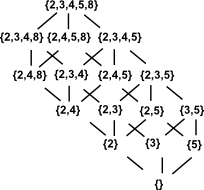 |
prime powers |
From this diagram we can create two operations [type signature of (int,int) -> int] called meet and join. In meet we go upwards in the diagram, from each of the nodes representing the operands, to find the first common node where they first meet. In join we go downwards in the diagram, from each of the nodes representing the operands, to find the first common node where they first join.
Meet /\
least common factor
| \/ | 1 | 2 | 3 | 4 | 5 | 6 | 8 | 10 | 12 | 15 | 20 | 24 | 30 | 40 | 60 | 120 |
|---|---|---|---|---|---|---|---|---|---|---|---|---|---|---|---|---|
| 1 | 1 | 2 | 3 | 4 | 5 | 6 | 8 | 10 | 12 | 15 | 20 | 24 | 30 | 40 | 60 | 120 |
| 2 | 2 | 2 | 6 | 4 | 10 | 6 | 8 | 10 | 12 | 30 | 20 | 24 | 30 | 40 | 60 | 120 |
| 3 | 3 | 6 | 3 | 12 | 15 | 6 | 24 | 30 | 12 | 15 | 60 | 24 | 30 | 120 | 60 | 120 |
| 4 | 4 | 4 | 12 | 4 | 20 | 12 | 8 | 40 | 12 | 60 | 20 | 24 | 60 | 40 | 60 | 120 |
| 5 | 5 | 10 | 15 | 20 | 5 | 30 | 40 | 10 | 60 | 15 | 20 | 120 | 30 | 40 | 60 | 120 |
| 6 | 6 | 6 | 6 | 12 | 30 | 6 | 24 | 30 | 12 | 30 | 60 | 24 | 30 | 120 | 60 | 120 |
| 8 | 8 | 8 | 24 | 8 | 40 | 24 | 8 | 40 | 24 | 120 | 40 | 24 | 120 | 40 | 120 | 120 |
| 10 | 10 | 10 | 30 | 40 | 10 | 30 | 40 | 10 | 60 | 30 | 20 | 120 | 30 | 40 | 60 | 120 |
| 12 | 12 | 12 | 12 | 12 | 60 | 12 | 24 | 60 | 12 | 60 | 60 | 24 | 60 | 120 | 60 | 120 |
| 15 | 15 | 30 | 15 | 60 | 15 | 30 | 120 | 30 | 60 | 15 | 60 | 120 | 30 | 120 | 60 | 120 |
| 20 | 20 | 20 | 60 | 20 | 20 | 60 | 40 | 20 | 60 | 60 | 20 | 120 | 60 | 40 | 60 | 120 |
| 24 | 24 | 24 | 24 | 24 | 120 | 24 | 24 | 120 | 24 | 120 | 120 | 24 | 120 | 120 | 120 | 120 |
| 30 | 30 | 30 | 30 | 60 | 30 | 30 | 120 | 30 | 60 | 30 | 60 | 120 | 30 | 120 | 60 | 120 |
| 40 | 40 | 40 | 120 | 40 | 40 | 120 | 40 | 40 | 120 | 120 | 40 | 120 | 120 | 40 | 120 | 120 |
| 60 | 60 | 60 | 60 | 60 | 60 | 60 | 120 | 60 | 60 | 60 | 60 | 120 | 60 | 120 | 60 | 120 |
| 120 | 120 | 120 | 120 | 120 | 120 | 120 | 120 | 120 | 120 | 120 | 120 | 120 | 120 | 120 | 120 | 120 |
Join \/
greatest common denominator
| /\ | 1 | 2 | 3 | 4 | 5 | 6 | 8 | 10 | 12 | 15 | 20 | 24 | 30 | 40 | 60 | 120 |
|---|---|---|---|---|---|---|---|---|---|---|---|---|---|---|---|---|
| 1 | 1 | 1 | 1 | 1 | 1 | 1 | 1 | 1 | 1 | 1 | 1 | 1 | 1 | 1 | 1 | 1 |
| 2 | 1 | 2 | 1 | 2 | 1 | 2 | 2 | 2 | 2 | 1 | 2 | 2 | 2 | 2 | 2 | 2 |
| 3 | 1 | 1 | 3 | 1 | 1 | 3 | 1 | 1 | 3 | 3 | 1 | 3 | 3 | 1 | 3 | 3 |
| 4 | 1 | 2 | 1 | 4 | 1 | 2 | 4 | 2 | 4 | 1 | 4 | 4 | 2 | 4 | 4 | 4 |
| 5 | 1 | 1 | 1 | 1 | 5 | 1 | 1 | 5 | 1 | 5 | 5 | 1 | 5 | 5 | 5 | 5 |
| 6 | 1 | 2 | 3 | 2 | 1 | 6 | 2 | 2 | 6 | 3 | 2 | 6 | 6 | 2 | 6 | 6 |
| 8 | 1 | 2 | 1 | 4 | 1 | 2 | 8 | 2 | 4 | 1 | 4 | 8 | 2 | 8 | 4 | 8 |
| 10 | 1 | 2 | 1 | 2 | 5 | 2 | 2 | 10 | 2 | 1 | 10 | 2 | 10 | 10 | 10 | 10 |
| 12 | 1 | 2 | 3 | 4 | 1 | 6 | 4 | 2 | 12 | 3 | 2 | 12 | 6 | 4 | 12 | 12 |
| 15 | 1 | 1 | 3 | 1 | 5 | 3 | 1 | 1 | 3 | 15 | 5 | 3 | 15 | 5 | 15 | 15 |
| 20 | 1 | 2 | 1 | 4 | 5 | 2 | 4 | 10 | 2 | 5 | 20 | 4 | 5 | 20 | 20 | 20 |
| 24 | 1 | 2 | 3 | 4 | 1 | 6 | 8 | 2 | 12 | 3 | 4 | 24 | 6 | 8 | 12 | 24 |
| 30 | 1 | 2 | 3 | 2 | 5 | 6 | 2 | 10 | 6 | 15 | 5 | 6 | 30 | 10 | 30 | 30 |
| 40 | 1 | 2 | 1 | 4 | 5 | 2 | 8 | 10 | 4 | 5 | 20 | 8 | 10 | 40 | 20 | 40 |
| 60 | 1 | 2 | 3 | 4 | 5 | 6 | 4 | 10 | 12 | 15 | 20 | 12 | 30 | 20 | 60 | 60 |
| 120 | 1 | 2 | 3 | 4 | 5 | 6 | 8 | 10 | 12 | 15 | 20 | 24 | 30 | 40 | 60 | 120 |
Diagrams
see Hasse diagram.
Relationship Between Poset and Algebra
We can represent a poset as a diagram:
| meet: where two branches meet above we have a meet /\ |  |
| join: where two branches meet beneath we have a join \/ |  |
Warning: different sources somtimes reverese the way that /\ and \/ are used so I am not sure which is the best standard to use?
Birkhoff's theorem
All distributive lattices can be represented by sets as follows:
| distributive lattice | set | poset | boolean |
|---|---|---|---|
| join operation \/ | union U | least upper bound (supremum) | or |
| meet operation /\ | intersection |
greatest lower bound (infimum) | and |
examples:
- the Boolean lattice defined from the family of all subsets of a finite set has this property.
- any finite topological space has a lattice of sets as its family of open sets.
Complemented lattice
In the mathematical discipline of order theory, a complemented lattice is a bounded lattice in which every element a has a complement, i.e. an element b satisfying a \/ b = 1 and a \/ b = 0.
An orthocomplementation on a bounded lattice is a function that maps each element a to an "orthocomplement" a¬ in such a way that the following axioms are satisfied:
- Complement law: a¬ \/ a = 1 and a¬ \/ a = 0.
- Involution law: a¬¬ = a.
- Order-reversing: if a ? b then b¬ ? a¬.
Boolean algebras are a special case of orthocomplemented lattices
